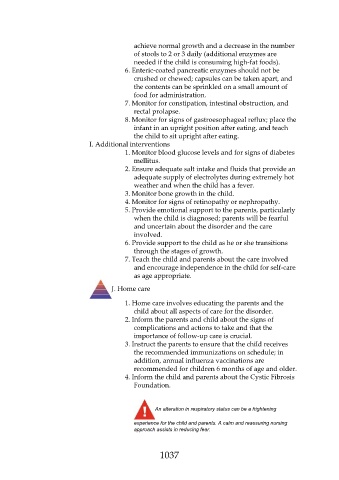Page 1037 - Saunders Comprehensive Review For NCLEX-RN
P. 1037
achieve normal growth and a decrease in the number
of stools to 2 or 3 daily (additional enzymes are
needed if the child is consuming high-fat foods).
6. Enteric-coated pancreatic enzymes should not be
crushed or chewed; capsules can be taken apart, and
the contents can be sprinkled on a small amount of
food for administration.
7. Monitor for constipation, intestinal obstruction, and
rectal prolapse.
8. Monitor for signs of gastroesophageal reflux; place the
infant in an upright position after eating, and teach
the child to sit upright after eating.
I. Additional interventions
1. Monitor blood glucose levels and for signs of diabetes
mellitus.
2. Ensure adequate salt intake and fluids that provide an
adequate supply of electrolytes during extremely hot
weather and when the child has a fever.
3. Monitor bone growth in the child.
4. Monitor for signs of retinopathy or nephropathy.
5. Provide emotional support to the parents, particularly
when the child is diagnosed; parents will be fearful
and uncertain about the disorder and the care
involved.
6. Provide support to the child as he or she transitions
through the stages of growth.
7. Teach the child and parents about the care involved
and encourage independence in the child for self-care
as age appropriate.
J. Home care
1. Home care involves educating the parents and the
child about all aspects of care for the disorder.
2. Inform the parents and child about the signs of
complications and actions to take and that the
importance of follow-up care is crucial.
3. Instruct the parents to ensure that the child receives
the recommended immunizations on schedule; in
addition, annual influenza vaccinations are
recommended for children 6 months of age and older.
4. Inform the child and parents about the Cystic Fibrosis
Foundation.
An alteration in respiratory status can be a frightening
experience for the child and parents. A calm and reassuring nursing
approach assists in reducing fear.
1037

